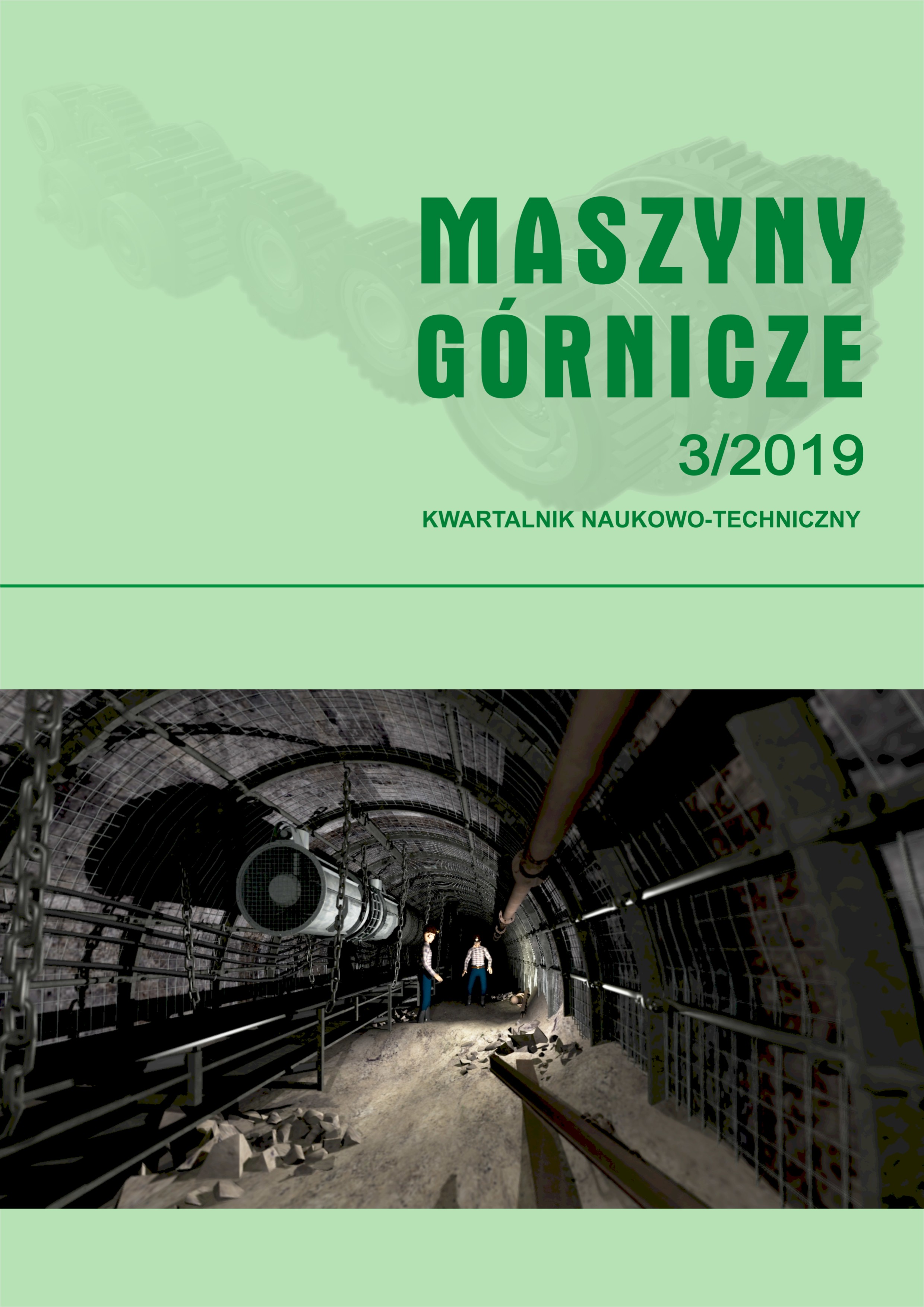Andrzej Figiel
Instytut Techniki Górniczej KOMAG
Badanie i ocena przewodów i kabli elektrycznych
Testing and assessment of electric cables
str. 3-9
| Przewody i kable elektryczne, optyczne i telekomunikacyjne, zanim zostaną wprowadzone do obrotu handlowego, podlegają ocenie za którą odpowiada ich producent. Użytkownik instalacji kablowych jest z kolei odpowiedzialny za prawidłowy dobór kabli i przewodów, ze względu na bezpieczeństwo osób użytkujących instalację. W artykule zaprezentowano wymagania dotyczące kabli i przewodów elektrycznych przeznaczonych do stosowania w podziemnych zakładach górniczych oraz zakres badań wymaganych podczas oceny dokonywanej przez ITG KOMAG. |
Before being placed on the market, electrical, optical and telecommunication cables shall undergo an assessment under the responsibility of their manufacturer. The user of the cable systems is responsible for the correct selection of cables for the safety of the persons using the system. The article presents the requirements for electrical cables intended for use in underground mines and the scope of tests required during the assessment carried out by ITG KOMAG. |
|
| Słowa kluczowe: kable elektryczne, instalacje kablowe, badania kabli
|
Keywords: electrical cables, cable installations, cable tests |
Amadeus Jagieła-Zając, Piotr Cheluszka
Politechnika Śląska
Pomiary ustawienia uchwytów nożowych na pobocznicy głowicy urabiającej kombajnu górniczego z wykorzystaniem widzenia stereoskopowego
Measurement of the pick holders position on the side surface of the cutting head of a mining machine with the use of stereoscopic vision
str. 10-23
| O efektywności urabiania skał kombajnami górniczymi decyduje w dużym stopniu układ noży, a więc liczba i sposób ich rozmieszczenia na organie roboczym maszyny urabiającej. Istotne znaczenie ma nie tylko prawidłowy dobór układu noży do danych warunków na etapie projektowania, lecz również zapewnienie zgodności z projektem gotowego wyrobu. Dąży się m.in. dlatego do robotyzacji procesu wytwarzania głowic/organów urabiających kombajnów górniczych. Z punktu widzenia możliwości robotyzacji procesu spawania uchwytów nożowych niezbędna jest ocena w czasie rzeczywistym ustawienia uchwytów nożowych względem powierzchni pobocznicy kadłuba głowicy urabiającej. Dogodnym sposobem jest tu wykorzystanie bezstykowych metod pomiaru, opartych na systemach wizyjnych. W artykule przedstawiono metodę wyznaczania ustawienia uchwytów nożowych względem pobocznicy kadłuba głowicy urabiającej kombajnu chodnikowego, w trakcie ich pozycjonowania, z wykorzystaniem systemu wizyjnego 3D. Przetwarzanie danych zrealizowane zostało w środowisku Matlab z wykorzystaniem bibliotek pakietu Computer Vision Toolbox. Przestawiono model matematyczny opisujący transformację obrazów zarejestrowanych przez kamery, w oparciu o którą wyznaczono rozkład odległości pomiędzy punktami podstawy uchwytu nożowego i pobocznicy kadłuba głowicy urabiającej, dla zadanego ustawienia uchwytu nożowego. Opracowaną metodę pomiaru przetestowano na stanowisku doświadczalnym zbudowanym w Laboratorium robotyki Katedry Mechanizacji i Robotyzacji Górnictwa Politechniki Śląskiej |
Before being placed on the market, electrical, optical and telecommunication cables shall undergo an assessment under the responsibility of their manufacturer. The user of the cable systems is responsible for the correct selection of cables for the safety of the persons using the system. The article presents the requirements for electrical cables intended for use in underground mines and the scope of tests required during the assessment carried oThe efficiency of rock cutting with mining machines is largely determined by the arrangement of picks, i.e. the number and their arrangement on the working unit of the mining machine. Not only the correct selection of the pick system for given conditions at the design stage is important, but also ensuring compliance with the design of the finished product. Strives, among others therefore, for robotisation of the process of manufacturing cutting heads/drums. From the point of view of the robotisation of the pick holders welding process, it is necessary to assess in real time the position of the pick holders relative to the side surface of the cutting head body. A convenient way is to use contactless measurement methods based on vision systems. The article presents a method of determining the position of pick holders relative to the side surface of the cutting head body of a roadheader, during their positioning, using a 3D vision system. Data processing was carried out in the Matlab software using the libraries of the Computer Vision Toolbox. A mathematical model describing the transformation of images recorded by cameras has been presented. On the basis of this model, the distribution of distances between the pick holder base points and the side surface of the cutting head was determined for a given pick holder setting. The developed measurement method was tested on an experimental stand built in the Laboratory of robotics of the Department of Mining Mechanization and Robotisation at the Silesian University of Technology.ut by ITG KOMAG. |
|
| Słowa kluczowe: głowica urabiająca, uchwyty nożowe, widzenie stereoskopowe, pomiary stereometrii
|
Keywords: cutter head, pick holders, stereoscopic vision, stereometry measurements |
Zbigniew Szkudlarek Sebastian Janas
Instytut Techniki Górniczej KOMAG
Wygarniacz portalowy
Portal stacker-reclaimer
str. 24-29
| W artykule przedstawiono koncepcję wygarniacza portalowego, przewidz. do zastosowania w branży energetycznej, głównie w magazynach gipsu instalacji odsiarczania spalin lub magazynach żużla piecowego. Oprócz wykorzystywania wygarniacza do dostarczania materiału sypkiego na linię produkcyjną może on pełnić rolę wstępnego mieszania materiałów sypkich. Składowany materiał może bowiem stanowić mieszaninę dużej ilości warstw o zróżnicowanym składzie chemicznym. W artykule przedstawiono budowę oraz opisano proces rozładunku materiału niehomogenizującego przez wygarniacz portalowy dwuramieniowy. Składowany materiał do dalszego wykorzystania jest pobierany z obu boków pryzmy. |
The concept of portal stacker-reclaimer to be used in the power industry, mainly in the gypsum storehouses for exhaust gases desulphurisation or in the furnace slag storehouses is presented. Apart using the portal stacker for delivery of loose materials to the production line, it can play a role of the initial mixer of loose materials. The stored material can be a mixture of many layers of different chemical composition. Design of the portal stacker is presented and the process of using two-arm portal stacker for unloading the material, which do not require homogenization, is described. The stored materials are taken from both sides of the prism. |
|
| Słowa kluczowe: inżynieria mechaniczna, budowa i eksploatacja maszyn, wygarniacz portalowy, proces rozładunku
|
Keywords: mechanical engineering, construction and operation of machines, portal reclaimer, unloading process |
Krzysztof Nieśpiałowski
Instytut Techniki Górniczej KOMAG
Elektropneumatyczne sterowanie filtra samoczyszczącego
Electropneumatic control system for self-cleaning filter
str. 30-41
| W artykule przedstawiono elektropneum. układ sterowania dedykowany do filtra samoczyszczącego FS-60 konstrukcji ITG KOMAG. Omówiono budowę i zasadę działania układu elektropneumatycznego. Rozwiązanie stanowi alternatywę dla istniejącego układu sterowania pneumatycznego. W artykule przedstawiono zalety i wady tego rozwiązania. |
The electropneumatic control system dedicated to FS-60 self-cleaning filter designed by KOMAG is presented. Design and principles of operation of the electropneumatic system is discussed. This solution is an alternative to the present pneumatic control system. Advantages and disadvantages of such |
|
| Słowa kluczowe: filtracja, filtr, filtr samoczyszczący, sterowanie, sterowanie elektropneumatyczne | Keywords: filtration, filter, self-cleaning filter, control system, electropneumatic control |
Krzysztof Okrent
KGHM ZANAM S.A.
Przemysław Deja, Bartosz Polnik
Instytut Techniki Górniczej KOMAG
Zastosowanie ogniw litowych do zasilania urządzeń technologicznych w górniczych wozach strzelniczych
The use of lithium batteries to power technological equipment in blasting utility vehicles
str. 42-49
| W samojezdnych wozach strzelniczych do napędu układu jezdnego zastosowany jest wysokoprężny silnik spalinowy. Natomiast do napędu urządzeń technologicznych, zabudowanych na tych wozach, stosowany jest silnik elektryczny, który napędza pompę hydrauliczną. Silnik elektryczny zasilany jest z kopalnianej sieci elektroenergetycznej o napięciu znamionowym 500 V za pośrednictwem rozwijanego przewodu elektrycznego. W artykule przedstawiono nowe, akumulatorowe rozwiązanie zasilania silnika elektrycznego samojezdnego wozu strzelniczego. Układ ten składa się z modułu baterii i aparatury, zabudowanych na wozie strzelniczym oraz wolnostojącego modułu ładowania. Wprowadzenie akumulatorowego zasilania układu roboczego zabudowanego na wozie, w miejsce stosowanego w dotychczasowych rozwiązaniach zasilania przewodowego, jest istotną innowacją wozu strzelniczego. Zastosowane w tym rozwiązaniu ogniwa litowe charakteryzują się wysoką gęstością energii oraz wysoką gęstością mocy, w stosunku do powszechnie stosowanych baterii ogniw kwasowo-ołowiowych i nie wydzielają gazów elektrolitycznych (np. wodoru) podczas eksploatacji. |
Self-propelled blasting utility vehicles are powered by diesel engines. However, electric motors are used to power the technological devices installed on these vehicles, and such a motor powers a hydraulic pump. The electric motors are powered from the mine's power grid with a rated voltage of 500 V via an unwound electric cable. A new battery solution for the electric motor of a self-propelled blasting utility vehicle is presented. This system consists of a battery module and fittings, installed on a blasting utility vehicle and a free-standing charging module. The introduction of battery power supply unit to the working system installed on the vehicle instead of the wired power supply used in existing solutions is an important innovation of the blasting utility vehicles. The lithium cells used in this solution are characterized by high energy density and high power density, compared to commonly used lead-acid batteries and during operation do not emit electrolytic gases (e.g. hydrogen). | |
| Słowa kluczowe: górnictwo, maszyny elektryczne, zasilanie akumulatorowe | Keywords: mining industry, electric machines, battery power supply system |
Krzysztof Nieśpiałowski
Instytut Techniki Górniczej KOMAG
Agregat hydrauliczny przeznaczony do zasilania napędu taśmowego urządzenia czyszczącego
Hydraulic power pack for supplying the drive of belt cleaning device
str. 50-55
| W niniejszym artykule zaprezentowano koncepcję agregatu hydraulicznego, przeznaczonego do zasilania układu napędowego taśmowego urządzenia czyszczącego, będącego zespołem pomocniczym głównych przenośników taśmowych. Agregat o zwartej konstrukcji wyposażono w pompę, wraz z zaworem przelewowym, zatopioną w zbiorniku oleju. Kompaktowa budowa umożliwi zabudowę agregatu wewnątrz konstrukcji nośnej przenośnika taśmowego. To z kolei pozwoli na sprzężenie wału pompy, za pomocą przekładni pasowej, z bębnem wysypowym przenośnika taśmowego. |
The concept of hydraulic power pack for supplying the drive of belt cleaning device being an auxiliary subassembly of the main belt conveyors is presented. The power pack of a compact design is equipped with a pump with an overflow valve and immersed in an oil tank. The compact design will enable installation of the power pack inside the load-bearing structure of a belt conveyor. This, in turn, will enable coupling the pump shaft, using a belt drive, with a discharge drum of the belt conveyor. | |
| Słowa kluczowe: górnictwo, transport urobku, urządzenie czyszczące, agregat hydrauliczny | Keywords: mining industry, run-of-mine transportation, cleaning device, hydraulic power pack |







